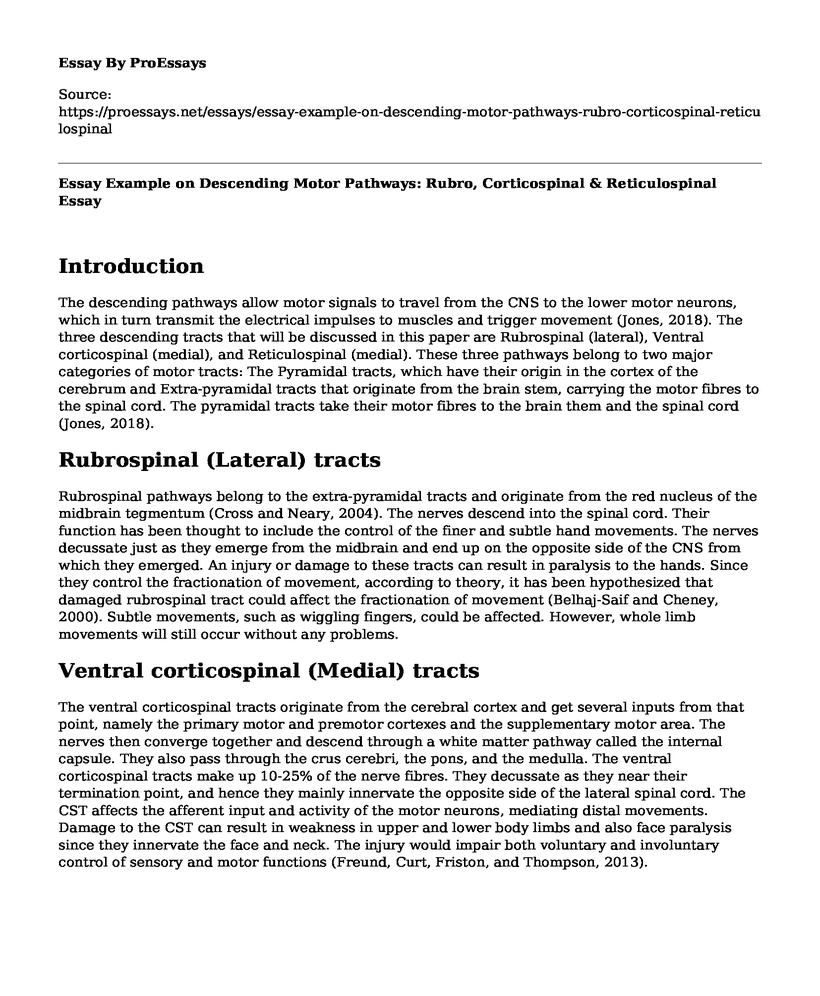Introduction
The descending pathways allow motor signals to travel from the CNS to the lower motor neurons, which in turn transmit the electrical impulses to muscles and trigger movement (Jones, 2018). The three descending tracts that will be discussed in this paper are Rubrospinal (lateral), Ventral corticospinal (medial), and Reticulospinal (medial). These three pathways belong to two major categories of motor tracts: The Pyramidal tracts, which have their origin in the cortex of the cerebrum and Extra-pyramidal tracts that originate from the brain stem, carrying the motor fibres to the spinal cord. The pyramidal tracts take their motor fibres to the brain them and the spinal cord (Jones, 2018).
Rubrospinal (Lateral) tracts
Rubrospinal pathways belong to the extra-pyramidal tracts and originate from the red nucleus of the midbrain tegmentum (Cross and Neary, 2004). The nerves descend into the spinal cord. Their function has been thought to include the control of the finer and subtle hand movements. The nerves decussate just as they emerge from the midbrain and end up on the opposite side of the CNS from which they emerged. An injury or damage to these tracts can result in paralysis to the hands. Since they control the fractionation of movement, according to theory, it has been hypothesized that damaged rubrospinal tract could affect the fractionation of movement (Belhaj-Saif and Cheney, 2000). Subtle movements, such as wiggling fingers, could be affected. However, whole limb movements will still occur without any problems.
Ventral corticospinal (Medial) tracts
The ventral corticospinal tracts originate from the cerebral cortex and get several inputs from that point, namely the primary motor and premotor cortexes and the supplementary motor area. The nerves then converge together and descend through a white matter pathway called the internal capsule. They also pass through the crus cerebri, the pons, and the medulla. The ventral corticospinal tracts make up 10-25% of the nerve fibres. They decussate as they near their termination point, and hence they mainly innervate the opposite side of the lateral spinal cord. The CST affects the afferent input and activity of the motor neurons, mediating distal movements. Damage to the CST can result in weakness in upper and lower body limbs and also face paralysis since they innervate the face and neck. The injury would impair both voluntary and involuntary control of sensory and motor functions (Freund, Curt, Friston, and Thompson, 2013).
Reticulospinal (Medial)
The reticulospinal tracts are composed of the pontine tract and the medullary tract from which it originates (Crossman and Neary, 2005). Functions mainly in locomotion and control of posture through the control of both alpha and gamma motor neurons (Crossman and Neary, 2005). It plays a role in the regulation of breathing and the circulatory system. It has been shown to participate in muscle contraction in primates (Bufford and Davidson, 2004). They decussate in the medulla and descended opposite to the lateral side of the spinal cord. Damage reticulospinal tract results in distorted gait, and since it is responsible for conveying activation/inhibitions signals for processing before passage to the spinal cord, its damage can lead to incorrect responses to external stimuli such as hunger (Gjelsvik 2008). The involuntary nervous system is 'spared.' Localized injury to the reticulospinal tracts only affects voluntary. Involuntary function in the body should remain unaffected by a damaged reticulospinal tract. The digestive system is mainly involuntary and will prevail functional even in the event of such an injury occurring.
References
Crossman AR, Neary D. Neuroanatomy: An Illustrated Color Text. Third Edition. London: Elsevier, 2004
Belhaj-Saif A, Cheney PD. Plasticity in the distribution of the red nucleus output to forearm muscles after unilateral lesions of the pyramidal tract. J Neurophysiol 2000; 83: 3147-53
Freund, P., Curt, A., Friston, K., and Thompson, A., 2013. Tracking changes following spinal cord injury: insights from neuroimaging. The Neuroscientist, 19(2), pp.116-128.
Crossman AR, Neary D. Neuroanatomy. An Illustrated color text. Third Edition. Philadelphia: Churchill Livingstone, 2005
Jones, O. (2018). The Descending Tracts. Teach Me Anatomy. https://teachmeanatomy.info/neuroanatomy/pathways/descending-tracts-motor/
Cite this page
Essay Example on Descending Motor Pathways: Rubro, Corticospinal & Reticulospinal. (2023, May 08). Retrieved from https://proessays.net/essays/essay-example-on-descending-motor-pathways-rubro-corticospinal-reticulospinal
If you are the original author of this essay and no longer wish to have it published on the ProEssays website, please click below to request its removal:
- Introduction to Innovation
- Effect of Cell Phone Use on People Essay
- Potential Ethical Considerations on International Thermonuclear Experimental Reactor (ITER) Project
- Innovative Healthcare Provision Essay
- Essential Skills to Get Ahead in Engineering: Problem-Solving, Creativity, & More! - Essay Sample
- Apple Inc: Pioneering Global Innovation and User Experience - Essay Sample
- Paper Sample: Fresh Graduate Pursues Master's in Electrical Engineering at KFUPM







